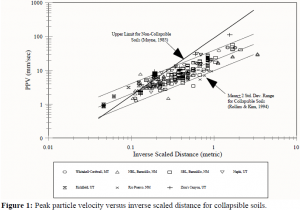Ryan J. Olsen and Dr. Kyle Rollins, Civil and Environmental Engineering
Collapsible soils, in their natural state, are stiff and strong. However, when they become wet these soils lose their strength and settle significantly. This settlement can damage highways and structures built over these collapsible soils. Deep dynamic compaction (DDC) is a method used for improving soil conditions by repeatedly dropping a very large tamper onto the ground from heights typically ranging from 50 to 100 ft. DDC has been shown to significantly increase the strength and stiffness of collapsible soils. However, vibrations caused by dynamic compaction may affect surrounding buildings.
In the past, correlations have been made for the influence of DDC on soils in general. However, the behavior of collapsible soils is quite different than that of non-collapsible soils. In 1994, Dr. Kyle Rollins and Ji-Hyoung Kim conducted research on the dynamic compaction of collapsible soils in several western states. They drew correlations to better understand the improvements of collapsible soils and the level of vibrations due to DDC.1 Since that time, DDC has been used to improve the strength and stiffness of collapsible soils at several more construction sites in the western United States.
Data was gathered from these recent construction projects where DDC has been used. Peak particle velocity (PPV) values recorded by seismographs at these construction sites were added to the previously recorded data resulting in 298 data points. With this increase in data points, correlations that are more general can be determined.
Figure 1 shows relationship between ground vibrations and the distance from the drop point by plotting the recorded PPV values versus the inverse scaled distance. The equation for the line of best fit for the data in figure 1 was determined to be
PPV = 20(WH)0.5/d
where d is the distance from the impact point, PPV is in mm/sec, W is tamper weight in metric tonnes, and H is drop height in meters.
As was stated, ground vibrations caused by DDC can affect nearby structures. The frequency of the vibrations often ranged from 5 to 40 Hz., but the peak values generally ranged between 10 and 20 Hz. Engineers must determine safe distances or compaction energies when using dynamic compaction so that the vibrations will be small enough not to cause any damage. This determination can be made using empirical correlations.
Figure 1 also shows the upper limit line determined by Mayne (1985) based on tests involving non-collapsible soils.2 In general, the collapsible soils result in lower PPV values at shorter distances, but these velocities decrease at a slower rate with distance from the drop point than non-collapsible soils. This suggests that compaction closer to adjacent buildings may be possible when performing DDC on collapsible soils.
Deep dynamic compaction is successfully being used to improve collapsible soils. However, ground vibrations caused by DDC can result in damage to nearby structures. By using empirical correlations the peak particle velocities can be predicted so that safe distances or compaction energy levels can be determined.
References
- Rollins, K.M., Kim, J. (1994) “U.S. Experience with Dynamic Compaction of Collapsible soils,” ASCE Geotechnical Special Publication No.45, In-situ Deep Soil Improvements, ASCE, P. 26-43.
- Mayne, P.W.; Jones J.W. and Dumas, J.C. (1984). “Ground Response to Dynamic Compaction.” J.Geotechnical Engineering., ASCE, 110(6), 757-774.

